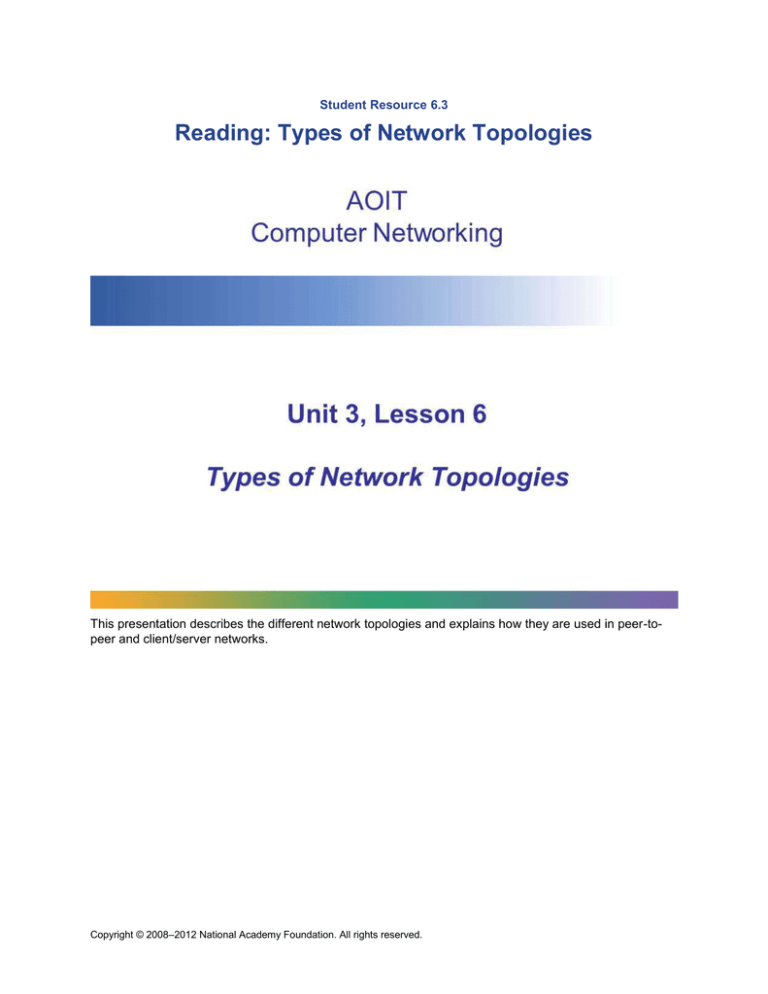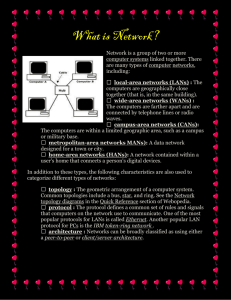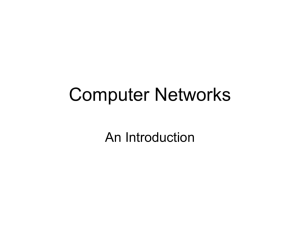
Student Resource 6.3
Reading: Types of Network Topologies
This presentation describes the different network topologies and explains how they are used in peer-topeer and client/server networks.
Copyright © 2008–2012 National Academy Foundation. All rights reserved.
AOIT Computer Networking
Lesson 6 Network Topologies
It is helpful for a network administrator to know the pros and cons of different network topologies when
putting together a network. By weighing the benefits of each type, the administrator can choose the
configuration that is most efficient for the network's intended purpose.
Copyright © 2008–2012 National Academy Foundation. All rights reserved.
AOIT Computer Networking
Lesson 6 Network Topologies
In a star topology, each computer is connected to a hub or switch. If a cable breaks, only the computer
attached via that cable is affected and is isolated from the network. Stars are one of the more common
topologies used today, used both in homes and in small and large businesses. All traffic that traverses the
network passes through the central hub. The hub acts as a signal booster or repeater.
The star topology is considered the easiest topology to design and implement. An advantage of the star
topology is the simplicity of adding additional nodes. The primary disadvantage of the star topology is that
the hub represents a single point of failure.
Star topologies are very common, especially in Ethernet networks. Also, they are commonly mixed with
one of the other topologies to create a hybrid topology.
Copyright © 2008–2012 National Academy Foundation. All rights reserved.
AOIT Computer Networking
Lesson 6 Network Topologies
In a token ring network, computers are attached to a special kind of hub called an MAU, or multistation
access unit. Inside the MAU, the computers are connected to each other in a ring formation. The network
sends a token around the ring. Only one computer can hold the token at once, and computers are
allowed to send information only when they hold the token. So, using the token prevents computers from
sending signals at the same time and having those signals collide and interfere with each other. Each
computer looks at the data being sent and picks it up only if it’s addressed to that computer. The
computers ignore packets addressed to other computers.
The original IBM token ring used Type-1 shield cable, but later generations of token ring networks also
support UTP cable as part of the IEEE 802.5 standard.
Some business networks still use ring formations, but these formations are no longer common on a LAN.
A star formation using UTP cable is much more common, because the switches used in large networks
are smarter at routing data to specific addresses.
Copyright © 2008–2012 National Academy Foundation. All rights reserved.
AOIT Computer Networking
Lesson 6 Network Topologies
In a bus topology, every computer or node taps into a central cable that has a terminator at each end.
Each computer claims any packets addressed to it and ignores packets addressed to other computers. It
is easy to connect computers to a linear bus, and it requires less cable than a star topology.
However, if the central cable breaks, it divides the network into two separate sections. This gap will mean
that computers on opposite sides of the break won’t be able to communicate. Also, if the entire network
shuts down, it’s difficult to locate the problem.
Today, this type of network topology isn't used very often except on large-scale networks connecting
many smaller networks. Even then, this is only a logical picture of what a bus topology looks like; bus
topologies are almost never physically configured this way.
Copyright © 2008–2012 National Academy Foundation. All rights reserved.
AOIT Computer Networking
Lesson 6 Network Topologies
In a mesh topology all nodes (for example, computers or other devices) are interconnected. A full mesh
topology links every node to every other node on the network.
Full mesh topology has the highest fault tolerance of all of the network topologies, but it is also usually the
most expensive and the most complex, because each connection needs its own cable. Every time you
add a client to a mesh network you have to run cables to each of the other devices. If your network has
four clients/devices, then you will need 6 cables. But if your network has 40 devices, you will need 780
cables. Also, troubleshooting to find the failed cable in such a network can be tricky. For these reasons,
the full mesh topology is rarely used today.
However, the full mesh topology is sometimes used in a WAN environment because of its fault tolerance.
Computers and other network devices can switch between the multiple redundant connections if the need
arises.
Copyright © 2008–2012 National Academy Foundation. All rights reserved.
AOIT Computer Networking
Lesson 6 Network Topologies
In a partial mesh topology, all computers can connect to all others by going through no more than a few
nodes.
WAN implementations sometimes use a partial mesh to create a redundant point-to-point network
connection between specific network devices. Using a partial mesh is a compromise between the need
for fault tolerance and the cost of a full mesh. The same technology can be used with a partial mesh, but
not all devices are interconnected. Deciding which devices have to be connected in order to ensure fault
tolerance requires careful strategic planning.
Copyright © 2008–2012 National Academy Foundation. All rights reserved.
AOIT Computer Networking
Lesson 6 Network Topologies
Stars, rings, buses, and mesh networks are the building blocks of network topologies. Many large
networks use a combination of these techniques, linking smaller stars, rings, or buses into a larger
network.
The image on this slide shows a small company’s network. The accounting department has three
computers linked to a hub in a star formation. The Sales department also has three computers linked via
a second hub, forming a second star topology. Then, the two hubs are connected in a bus topology to a
central switch. This central line linking the two hubs could be called the network backbone, because each
section of the network relies on that central cable.
Copyright © 2008–2012 National Academy Foundation. All rights reserved.
AOIT Computer Networking
Lesson 6 Network Topologies
The ring, bus, star, and mesh topologies all describe networks by their shape. But networks can also be
classified by the distances they cover.
Mostly we have discussed local area networks (LANs) so far. LANs are usually confined to a building or a
few close buildings. They can be very small, like a home network, or connect hundreds of computers.
LANs consist of laptop or desktop computers that might connect with a printer, fax machine, server, or
other devices. LANs don’t have to be connected to the Internet, but many are.
Metropolitan area networks (MANs) connect multiple locations in one geographical region, such as a
county or city. For example, your school is probably connected to a server in the central school district
office, as are all the other schools. From there, the district has a line connecting all those computers to
the Internet. A large business might have a warehouse, a factory, and an office all in the same city, so it
connects through a MAN.
A wide area network (WAN) also connects many locations on one network. It can cross regional or
national boundaries and might be used by a very large company that does business internationally. For
example, a company might have factories in China, headquarters in the UK, and offices in the US, and all
of their employees need to be able to communicate with each other.
Both MANs and WANs are used to connect multiple LANs. So, in each office or school, the users would
use desktop computers in a local network, which is then connected to a MAN or a WAN. The Internet is
the largest WAN of all.
Copyright © 2008–2012 National Academy Foundation. All rights reserved.
AOIT Computer Networking
Lesson 6 Network Topologies
On a peer-to-peer (P2P) network, all computers have equal ability to communicate and control
documents. All computers have the ability to work both as a client and as a server. All computers can
share files with others, request files from other computers, and access office machines such as the fax
machine or printer.
Since there isn’t a central computer controlling what the computers on a peer-to-peer network have
access to, security is typically controlled by the end user. For example, if you own the desktop computer
shown on the slide, it is your responsibility to configure who can see what on your local machine.
Copyright © 2008–2012 National Academy Foundation. All rights reserved.
AOIT Computer Networking
Lesson 6 Network Topologies
In a client/server network, one computer is set up to function only as a server. The server controls the
access that other computers have to shared resources such as documents, fax machines, and printers.
Some servers are set up to perform multiple functions, while others perform only one particular task. For
example, a web server might be responsible only for serving up a web page, while an email server allows
employees to receive and send email.
The server can function on local, metropolitan, or wide area networks. On the local network, for example,
it might function as a file server. In many businesses, employees’ work documents are saved to a folder
that is stored and saved on a server machine. The folder has a shortcut on the worker’s desktop so that
she can easily find the files. By saving files to the server, the network administrator can back up every
document more easily. If the desktop computer crashes, the information will still be stored on the server.
These employee folders might be password-protected so that other employees can’t access them, even
though they are all working off of the same shared server.
The server might also store files for use on the Internet. When you go on the Internet and look up a web
page, your computer requests the documents stored on a web server somewhere. If you load the USA
Today news site, for example, the articles will be loaded from documents on servers that USA Today
owns or leases. The servers answer your request by sending you the files, which are temporarily stored in
your computer so that you can view them.
Copyright © 2008–2012 National Academy Foundation. All rights reserved.
AOIT Computer Networking
Lesson 6 Network Topologies
Servers can be small computers or enormous racks of motherboards and hard drives. Here is an image of
Google’s first production server.
Original caption courtesy photographer Steve Jurvetson:
Google’s First Production Server ... with the hair pulled back, revealing a rack of cheap networked PCs,
circa 1999. Each level has a couple of PC boards slammed in there, partially overlapping. This approach
reflects a presumption of rapid obsolescence of cheap hardware, which would not need to be repaired.
Several of the PCs never worked, and the system design optimized around multiple computer failures.
According to Larry and Sergey, the beta system used Duplo blocks for the chassis because generic brand
plastic blocks were not rigid enough.
Image credit:
Jurvetson, Steve. “Google’s First Production Server.” Wikimedia Commons,
http://commons.wikimedia.org/wiki/File:Google%E2%80%99s_First_Production_Server.jpg (accessed
May 21, 2012). Image reproduced here under the terms of the Creative Commons Attribution 2.0 Generic
license.
Copyright © 2008–2012 National Academy Foundation. All rights reserved.
AOIT Computer Networking
Lesson 6 Network Topologies
There are lots of aspects to consider when building a network. You need to think about how the
computers will be physically connected to each other, how much physical distance there is between the
computers, and how the computers on the network will share resources.
Copyright © 2008–2012 National Academy Foundation. All rights reserved.
AOIT Computer Networking
Lesson 6 Network Topologies
Student Resource 6.4
Business Presentation: Network Topologies
Directions: Your teacher will assign one of the network topology problems described in this resource to
your group. Work with your group to create a presentation as described in the following scenario. Be sure
to review the assessment criteria for this assignment before you begin work.
Consulting Team Scenario
You are part of a consulting team being hired by one of the businesses described below to set up its
computer network. You must decide what type of network will be best for the business—including what
topology to use, whether it will be a local area network (LAN), a metropolitan area network (MAN), or a
wide area network (WAN), and whether it will be a peer-to-peer network or a client/server network.
The managers expect you to write up a proposal describing your plans and present your proposal to them
in a meeting. The management team is not tech-savvy and doesn’t understand much about computer
networks, so you will have to explain the technical details in common, everyday English.
Your job is to persuade the management team to approve this proposal. If you don’t convince them, they
might hire another consulting team instead. So, your job depends upon the success of your presentation.
The management team will expect you to have the following materials, which must all be neat, legible,
and presentable:
An agenda for your discussion, outlining the main sections of the talk you’ll give
A poster or PowerPoint diagram illustrating how you propose to set up the network
A written list or description of the advantages of the network you’re proposing
A written list or description of how the network might be expanded if the company continues to
grow
Along with these materials, the managers are expecting you to deliver a three- to five-minute oral
presentation explaining the diagram to them and giving your rationale for setting up the network this way.
Computer Network Problems
Your teacher will assign one of these scenarios to your group.
1. The local school district has decided to approve a new computer academy. They want to install a
new computer lab with 20 new computers running Windows XP. Currently, the other labs are
hooked up in a bus topology, and the entire school network is hooked into a central switch at the
main district.
2. Jane Summer is a self-employed accountant who has recently hired three new employees to help
with her business. Her company has four desktop computers. Right now, only Jane’s computer is
hooked up to the Internet and the printer. Everyone else in the office uses USB drives to share
files. They load documents onto Jane’s computer whenever they want to print something. Jane
wants to set up a network to enable file sharing, allow printing from all of the computers, and
enable each employee to use the Internet. If business keeps growing as expected, she also plans
within the next six months to hire another contractor, who will bring in a laptop to use in the office.
3. A local store is expanding its business and opening a new shop on the other side of town. Right
now, the two stores are operating independently. At each store, there is one sales register, one
desktop computer, and one printer. The managers use the computers to design store signs and
Copyright © 2008–2012 National Academy Foundation. All rights reserved.
AOIT Computer Networking
Lesson 6 Network Topologies
do accounting. They want a network that will allow them to access all of the company files at both
locations and to do all of the accounting from one computer.
4. A nonprofit organization has 20 full-time employees who help provide services for the homeless,
from one central office in the city. All of the employees use desktop computers, but only the
managers are set up with network access. All of the employees have to keep records on the
people they help, but right now, all these records are kept in paper files and stored in file
cabinets. The managers have just received a new grant for funding and want to use the money to
bring their network up-to-date. They want to be able to keep electronic records and give all of the
employees access to the Internet, email, and the company printer. In the next few years, they
expect to open up a new office in a different part of the city and hire 5 to 10 more employees to
staff that office.
Make sure your presentation meets or exceeds the following assessment criteria:
The agenda lists the important items for discussion.
The diagram clearly and accurately illustrates the proposed network topology.
The explanation of the diagram in the presentation is accurate.
In the presentation, students clearly describe the advantages of the network being proposed.
The presentation addresses scalability, or how the network might be expanded should the
business continue growing.
Visual and written materials are neat, with proper spelling and grammar.
Copyright © 2008–2012 National Academy Foundation. All rights reserved.







